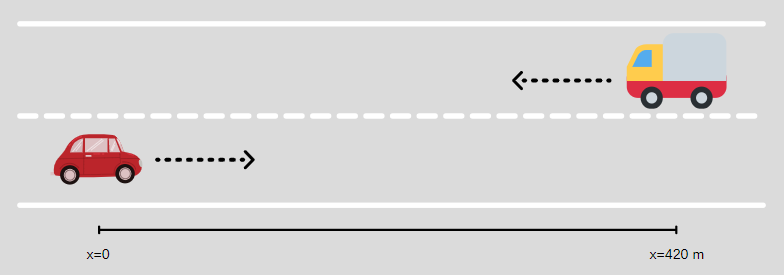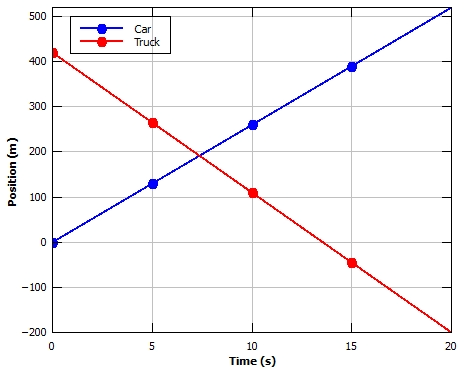
All Solutions
Page 62: Practice Problems
$$
begin{align*}
x_{f}^{(1)}&=x_{i}^{(1)}+v^{(1)}t\
&=left(4.20 frac{text{m}}{text{s}}right)times t tag{1}\\
\
\
\
x_{f}^{(2)}&=x_{i}^{(2)}+v^{(2)}t\
&=7.8 text{m}+left(2.30 frac{text{m}}{text{s}}right)times t tag{2}\\
end{align*}
$$
$$
begin{align*}
x_{f}^{(2)}&=7.8 text{m}+left(2.30 frac{text{m}}{text{s}}right)times 2.2 text{s}\
&=7.8 text{m}+5.06 text{m}\
&=12.9 text{m}\
end{align*}
$$
Here, we used $textbf{the rule for addition and subtraction to determine the number of significant figures in the answer.}$
$$
begin{align*}
t&=dfrac{x_{f}^{(1)}}{v^{(1)}}\
&=dfrac{12.9 text{m}}{4.20 frac{text{m}}{text{s}}}\
&=quadboxed{3.07 text{s}}\
end{align*}
$$
When writing the final result, we used $textbf{the rule for multiplication and division to determine the number of significant figures.}$
begin{align*}
boxed{t=3.07 text{s}}\
end{align*}
$$
$$
x_{f}^{(c)}=x_{i}^{(c)}+v^{(c)}t
$$
$boxed{x_{f}^{(c)}=left(26 frac{text{m}}{text{s}}right)times t}$
The truck’s initial position is $x_{i}^{(t)}=420 text{m}$, and its velocity is negative because it’s moving in the opposite direction. Therefore, the equation of motion of the truck is
$$
x_{f}^{(t)}=x_{i}^{(t)}+v^{(t)}t
$$
$boxed{x_{f}^{(t)}=420 text{m}-left(31 frac{text{m}}{text{s}}right)times t}$

$$y=a+bx$$
$$bigDownarrow$$
[x_{f}^{(c),(t)} = x_{i}^{(c),(t)}+v^{(c),(t)}t]
so you just have to plug in arbitrary values of $x_{f}^{(c),(t)}$ to get the values of $t$, or vice versa.\
The positions of both vehicles for 4 different values of $t$ are given in the table, below which is the position-time graph.\
begin{center}
begin{tabular}{|c|c|c|}
hline
textbf{Time (s)} & textbf{Car position (m)} & textbf{Truck position (m)}\
hline
0&0&420\
hline
5&130&265\
hline
10&260&110\
hline
15&390&-45\
hline
20&520&-200\
hline
end{tabular}
end{center}

$$
begin{align*}
x_{f}^{(c)}&=x_{f}^{(t)}\
26 frac{text{m}}{text{s}}times t&=420 text{m}-31 frac{text{m}}{text{s}}times t\
57 frac{text{m}}{text{s}}times t&=420 text{m}\
t&=dfrac{420 text{m}}{57 frac{text{m}}{text{s}}}\
&=7.368421053 text{s}\
&=quadboxed{7.4 text{s}}\
end{align*}
$$
As always, the rule for multiplication and division for significant figures was used when writing the final result.
begin{align*}
textbf{(a)} quad &text{The equation of motion for the car:}quadquadboxed{x_{f}^{(c)}=left(26 frac{text{m}}{text{s}}right)times t}\
&text{The equation of motion for the truck:}quadboxed{x_{f}^{(t)}=420 text{m}-left(31 frac{text{m}}{text{s}}right)times t}\
\
\
\
textbf{(b)} quad &text{Click to see the position-time graph.}\
\
\
\
textbf{(c)} quad &boxed{t=7.4 text{s}}\
end{align*}
$$
Haven't found what you were looking for?
Search for samples, answers to your questions and flashcards

